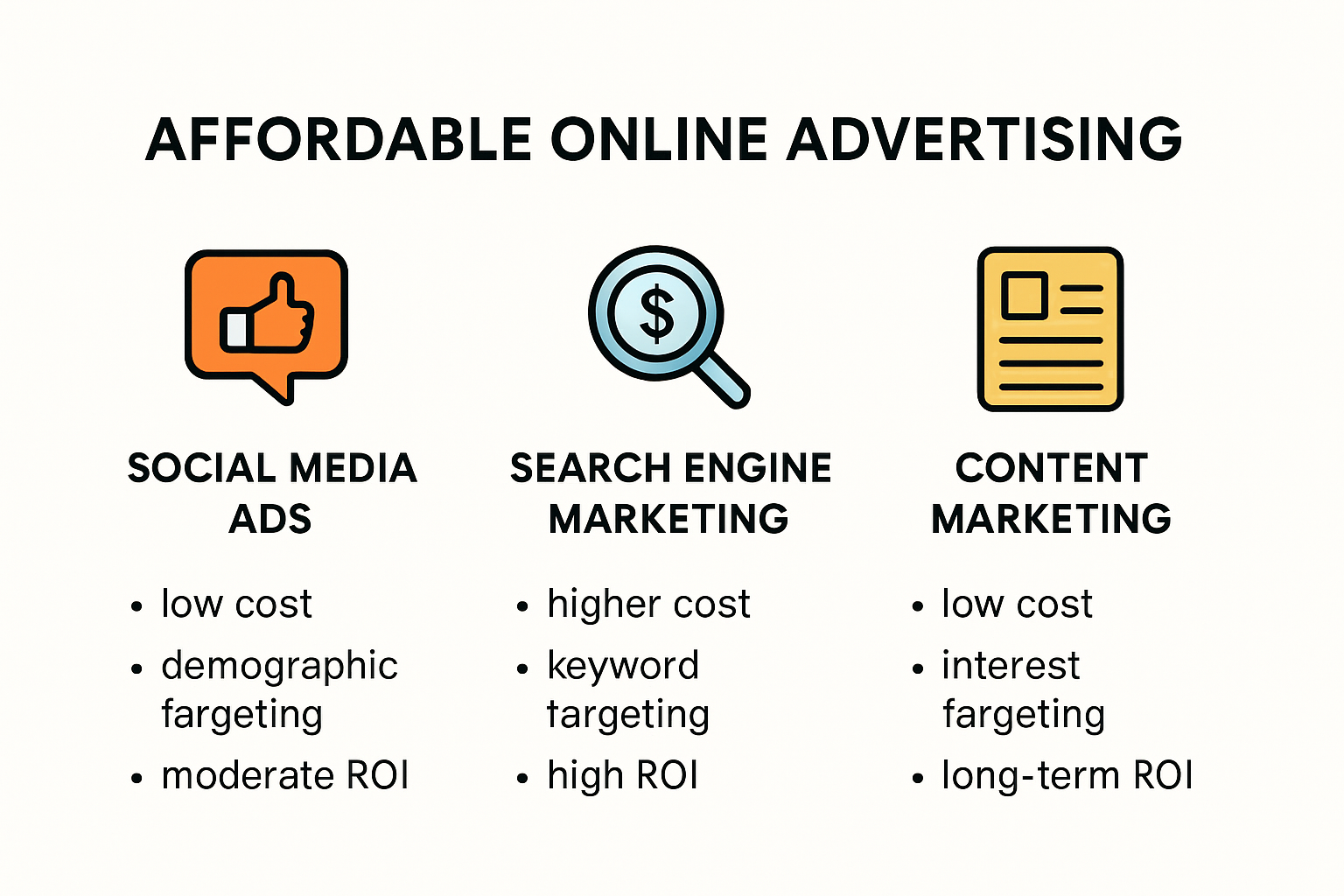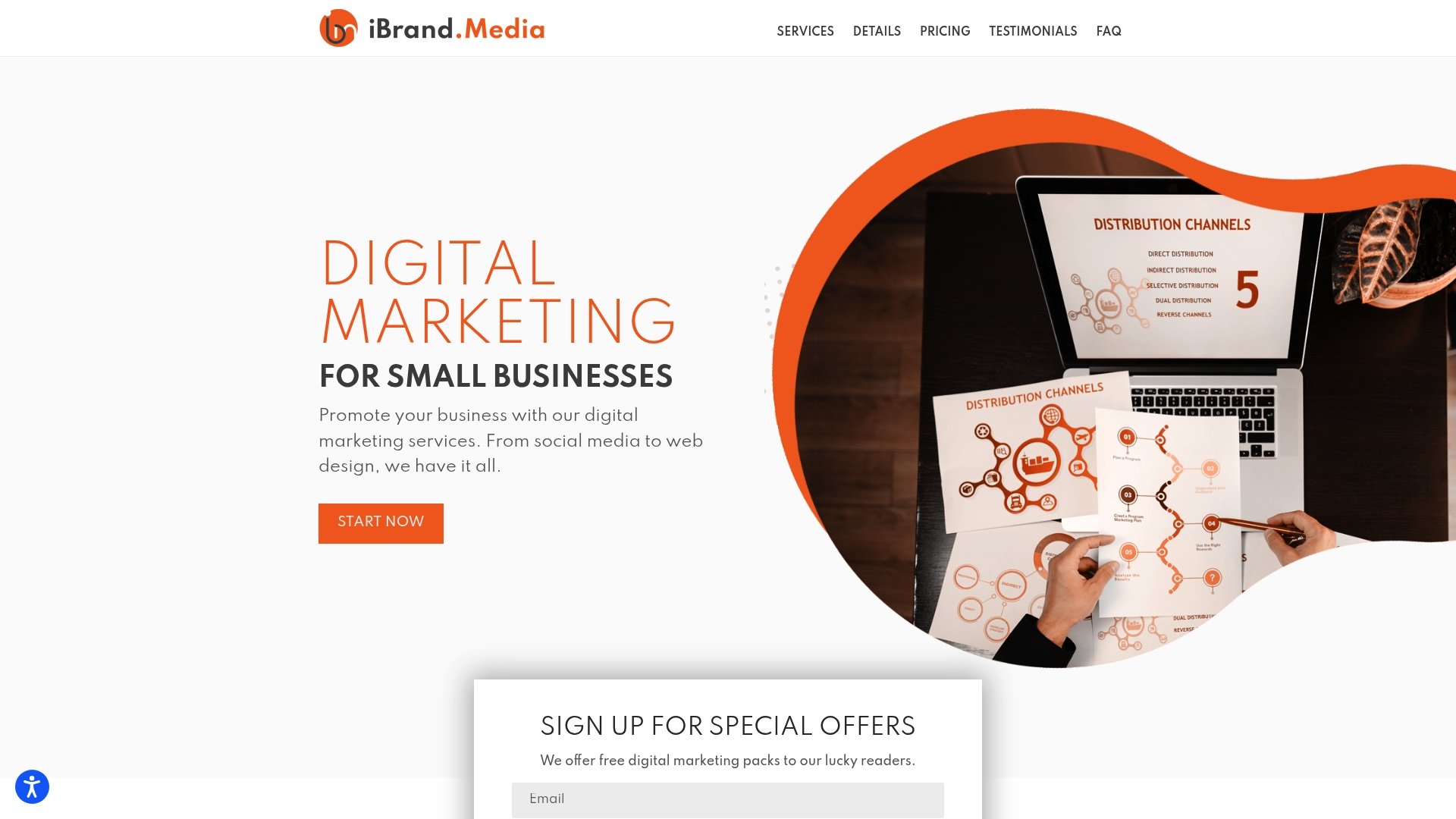
Online advertising in 2025 can look intimidating for small businesses trying to stretch every dollar. Here is something that flips the script. Research shows that you can start effective social media ads with as little as five dollars a day. Big budgets are not required to get noticed and drive real results. The newest strategies are all about stretching your budget in ways your competitors might never expect.
Table of Contents
- Best Low-Cost Digital Advertising Channels
- Creative Ways to Maximize Your Ad Budget
- Affordable Advertising Ideas for Local Businesses
- How to Measure Success With Affordable Ads
Quick Summary
| Takeaway | Explanation |
|---|---|
| Leverage Social Media Advertising | Utilize platforms like Facebook and Instagram for precise targeting with minimal budgets, starting as low as $5, to efficiently reach specific audience segments. |
| Implement Search Engine Marketing | Take advantage of PPC advertising to capture high-intent customers by paying only for clicks, with budgets starting around $10 per day. |
| Focus on Content Marketing | Develop valuable content to attract organic traffic and engage potential customers without continuous ad spending, establishing authority in your niche. |
| Employ Micro-Targeting Strategies | Use granular audience segmentation to personalize advertising experiences, improving conversion rates and reducing costs by up to 30%. |
| Optimize Ad Performance Continuously | Use A/B testing and real-time adjustments to refine your advertising strategies based on performance metrics, ensuring smarter budget allocation. |
Best Low-Cost Digital Advertising Channels
Small businesses need strategic digital advertising channels that maximize impact while minimizing expenses. Understanding the most affordable and effective online advertising options can transform marketing outcomes without breaking the bank.

Social Media Advertising: The Budget-Friendly Powerhouse
Social media advertising represents one of the most cost-effective digital marketing strategies for small businesses. Platforms like Facebook, Instagram, and LinkedIn offer incredibly precise targeting capabilities that allow businesses to reach specific audience segments without massive financial investments.
With minimal daily budgets starting as low as $5, businesses can create targeted campaigns that connect directly with potential customers. The advanced targeting options enable entrepreneurs to narrow down audiences based on demographics, interests, behaviors, and geographic locations. This precision means every advertising dollar works harder and more efficiently.
For instance, a local HVAC business can target homeowners within a specific zip code who have shown interest in home improvement, ensuring their ads reach the most relevant potential customers. The ability to track and adjust campaigns in real-time further enhances the cost-effectiveness of these platforms.
Search Engine Marketing: Capturing High-Intent Customers
Search engine marketing provides another affordable pathway for small businesses to attract customers. Pay-per-click (PPC) advertising allows businesses to appear in search results only when potential customers actively search for relevant services. This model ensures you only pay when someone clicks on your advertisement, making it a highly efficient marketing approach.
Google Ads and Bing Ads offer flexible budgeting options that can start as low as $10 per day. By carefully selecting keywords, creating compelling ad copy, and designing landing pages that convert, small businesses can generate significant returns on minimal investments. The key is understanding your target audience’s search behaviors and crafting messages that directly address their needs.
A home service contractor, for example, could create targeted ads for specific services like emergency plumbing repairs, appearing precisely when potential customers are searching for immediate solutions. This approach combines affordability with high conversion potential.
Content Marketing: The Long-Term Affordable Strategy
Content marketing emerges as an incredibly cost-effective digital advertising channel that builds sustained audience engagement. By creating valuable, informative content, businesses can attract organic traffic without continuous ad spending. Blog posts, videos, and infographics can establish authority and draw potential customers through search engines and social media sharing.
Our comprehensive guide on advertising channels offers deeper insights into implementing these strategies effectively. Small businesses can leverage free or low-cost platforms like WordPress, YouTube, and Medium to distribute content, reducing traditional advertising expenses while building meaningful connections with their target audience.
The most successful small businesses recognize that affordable online advertising isn’t about spending the most money, but about spending smartly. By combining these low-cost digital channels strategically, entrepreneurs can create robust marketing approaches that deliver impressive results without astronomical budgets.
Here is a comparison table summarizing the key features and typical budgets of the main low-cost digital advertising channels discussed above:
| Channel | Typical Minimum Daily Budget | Key Benefits | Example Tactics |
|---|---|---|---|
| Social Media Advertising | $5 | Highly targeted, real-time adjustment, measurable | Geo-targeted ads, interest segmentation |
| Search Engine Marketing | $10 | High intent audience, pay-per-click efficiency | Local keyword ads, service-specific campaigns |
| Content Marketing | As low as $0 | Organic traffic growth, brand authority | Blog posts, videos, guest articles |
Creative Ways to Maximize Your Ad Budget
Small businesses must approach digital advertising with strategic precision, turning limited resources into maximum marketing impact. Creative budget optimization requires understanding sophisticated techniques that stretch every advertising dollar while generating meaningful results.
Leveraging Micro-Targeting and Audience Segmentation
Micro-targeting strategies represent a powerful approach for small businesses seeking cost-efficient advertising solutions. By breaking down potential customer groups into ultra-specific segments, businesses can create highly personalized advertising experiences that dramatically improve conversion rates.
According to research from Buffer, businesses that implement granular audience segmentation can reduce advertising costs by up to 30% while increasing engagement. This means identifying precise demographic characteristics, behavioral patterns, and specific interests that align closely with your product or service.
For example, a local HVAC contractor might target homeowners between 35-55 years old, with household incomes above $75,000, who have recently searched for home improvement resources. This laser-focused approach ensures that every advertising dollar reaches the most likely potential customers.
Embracing Low-Cost and No-Cost Marketing Channels

Creative marketers understand that not all effective advertising requires substantial financial investment. Our comprehensive guide on advertising strategies highlights alternative channels that provide exceptional value without draining budgets.
Influencer marketing with micro-influencers offers an innovative approach for small businesses. These content creators typically have smaller but highly engaged audiences, allowing businesses to collaborate at a fraction of traditional advertising costs. A local restaurant might partner with a neighborhood food blogger, generating authentic content that reaches precisely targeted potential customers.
Email marketing continues to demonstrate remarkable return on investment. Research indicates that email campaigns can generate up to $36 for every $1 spent, making it one of the most cost-effective marketing strategies available to small businesses.
Optimizing Ad Performance Through Continuous Experimentation
Successful budget maximization requires continuous learning and adaptation. Small businesses should implement a systematic approach to testing and refining their advertising strategies. This means creating multiple ad variations, tracking performance metrics, and quickly pivoting based on real-world data.
A/B testing allows businesses to compare different advertising approaches, identifying which messages, visuals, and targeting parameters generate the most cost-effective results. By allocating smaller initial budgets to experimental campaigns, businesses can gather valuable insights without risking significant financial resources.
How to Run Social Ads provides additional insights into developing these experimental strategies. The key is maintaining flexibility and viewing each advertising effort as a learning opportunity.
Ultimately, maximizing an advertising budget is about intelligent allocation, precise targeting, and continuous optimization. Small businesses that approach digital advertising with creativity, data-driven decision-making, and a willingness to experiment can achieve remarkable results, even with limited financial resources.
Affordable Advertising Ideas for Local Businesses
Local businesses face unique challenges in marketing, requiring innovative and budget-conscious approaches to reach potential customers. Effective advertising doesn’t necessarily demand massive financial investments but instead requires creativity, strategic thinking, and leveraging community connections.
Maximizing Local Online Visibility
Google My Business optimization represents a critical first step for local businesses seeking affordable online advertising. According to recent research, local search queries have surged by over 200% since 2017, making digital presence crucial for small businesses. By claiming and fully optimizing your Google My Business listing, you can appear prominently in local search results and ‘near me’ searches without spending additional advertising dollars.
Key optimization strategies include adding high-quality photos, maintaining accurate business information, responding to customer reviews, and regularly updating your business profile. A local plumber, for instance, can showcase before-and-after project images, highlight service areas, and share customer testimonials to increase credibility and search visibility.
Here is a brief checklist table of best practices for optimizing Google My Business for local visibility:
| Optimization Step | Status (Done/To Do) |
|---|---|
| Claim and verify your business listing | |
| Add high-quality, up-to-date photos | |
| Ensure accurate business information | |
| Respond to customer reviews | |
| Update business profile regularly | |
| Highlight service areas | |
| Share customer testimonials |
Community-Driven Marketing Partnerships
Collaborative marketing strategies offer an innovative approach to expanding marketing reach without significant financial investment. By forming strategic partnerships with complementary local businesses, entrepreneurs can create mutually beneficial promotional opportunities.
For example, a local coffee shop might partner with a nearby bakery to offer combined promotional packages. A home contractor could collaborate with interior designers to cross-promote services. These partnerships allow businesses to tap into each other’s customer bases, effectively multiplying marketing reach without additional advertising expenses.
Our comprehensive guide to local marketing provides additional insights into developing these collaborative strategies. The key is identifying businesses with aligned but non-competing customer demographics.
Leveraging Low-Cost Digital Marketing Channels
Social media platforms provide powerful, cost-effective advertising opportunities for local businesses. Facebook and Instagram offer hyper-local targeting options that allow businesses to reach specific geographic areas and demographic segments with minimal financial investment. Businesses can create engaging content that resonates with local audiences, share community stories, and utilize location-based hashtags to increase visibility.
User-generated content can be particularly effective. Encouraging customers to share their experiences, tag your business, and participate in local-themed challenges can generate organic reach and credibility. A local restaurant might create a monthly photo contest featuring customer dishes, while a fitness studio could showcase member transformation stories.
Email marketing remains another low-cost channel for local businesses. By building a targeted email list of local customers and providing valuable, location-specific content, businesses can maintain engagement without significant advertising expenses. Newsletters can include local event information, seasonal promotions, and exclusive community offers.
Successful local advertising is about understanding your community, creating genuine connections, and strategically leveraging available resources. Small businesses that approach marketing with creativity, authenticity, and a focus on local relationships can achieve remarkable results without breaking the bank. The most effective advertising doesn’t always require the largest budget but instead demands thoughtful, targeted, and community-centered strategies.
How to Measure Success With Affordable Ads
Measuring the effectiveness of online advertising requires more than just tracking basic metrics. Small businesses need a comprehensive approach to understanding their return on investment, ensuring that every advertising dollar generates meaningful results.
Understanding Key Performance Indicators
Cost Per Acquisition (CPA) emerges as a critical metric for small businesses evaluating their advertising effectiveness. This metric calculates the total cost of acquiring a single customer through a specific marketing campaign. According to research, a lower CPA indicates more efficient advertising spending.
For example, if a local business spends $500 on a digital marketing campaign and generates 25 new customers, the CPA would be $20 per customer. Businesses should continuously work to reduce this number by refining targeting, improving ad creative, and optimizing landing pages.
Click-Through Rate (CTR) provides another crucial insight into ad performance. Current industry benchmarks suggest average CTRs of 3.17% for search ads and 0.46% for display ads. A higher CTR indicates that the ad resonates with the target audience, suggesting effective messaging and targeting.
Here is a summary table of key performance metrics for affordable online advertising, including industry benchmarks from the content:
| Metric | Industry Benchmark | Description |
|---|---|---|
| Cost Per Acquisition (CPA) | Varies ($20 shown) | Cost to acquire a customer from ads |
| Click-Through Rate (Search Ads) | 3.17% | CTR for text/search ads |
| Click-Through Rate (Display) | 0.46% | CTR for display/banner ads |
| Conversion Rate (Search Ads) | 3.75% | % of search ad clicks completing desired action |
| Conversion Rate (Display Ads) | 0.77% | % of display ad clicks completing desired action |
| Email ROI | $36 per $1 spent | Return per $1 spent on email marketing |
Conversion Rate Analysis
Conversion rate represents the ultimate measure of advertising success. Research indicates that average conversion rates hover around 3.75% for search ads and 0.77% for display ads. This metric tracks the percentage of users who complete a desired action after clicking an advertisement.
Our guide to affordable digital marketing suggests implementing a comprehensive tracking system that goes beyond surface-level metrics. Small businesses should define specific conversion goals, whether that means product purchases, service bookings, newsletter sign-ups, or phone call inquiries.
A local HVAC contractor might track conversions differently than an online retail store. For service-based businesses, a conversion could be a scheduled consultation, while an e-commerce site would measure completed purchases. The key is establishing clear, measurable objectives that align with business goals.
Advanced Tracking and Optimization Strategies
Modern advertising platforms offer sophisticated tracking tools that enable businesses to dive deep into performance analytics. Social ad strategies recommend utilizing platform-specific analytics to understand audience behavior, engagement patterns, and conversion paths.
Implementing conversion tracking pixels, setting up Google Analytics goals, and using UTM parameters can provide granular insights into how different advertising channels and campaigns perform. Small businesses can create custom dashboards that aggregate data from multiple sources, allowing for quick performance assessments.
It’s crucial to approach measurement as an ongoing process of learning and refinement. Successful advertisers don’t just collect data they actively use insights to adjust targeting, refine messaging, and improve overall campaign performance. This might mean testing different ad creatives, experimenting with audience segments, or reallocating budget to the most effective channels.
Ultimately, measuring advertising success is about understanding the story behind the numbers. Small businesses that develop a nuanced approach to performance tracking can turn limited advertising budgets into powerful growth engines, making every marketing dollar work harder and smarter.
Frequently Asked Questions
What are some affordable online advertising channels for small businesses in 2025?
Using platforms like social media (starting at $5 a day), search engine marketing (PPC starting at $10), and content marketing (potentially free) can help small businesses reach audiences effectively without large budgets.
How can small businesses maximize their advertising budget?
Small businesses can maximize their advertising budget by leveraging micro-targeting, embracing low-cost marketing channels, and continuously optimizing ad performance through A/B testing and real-time adjustments.
What is the importance of Google My Business for local advertising?
Google My Business is crucial for local advertising as it helps businesses appear prominently in local search results, driving traffic and footfall to their physical locations without incurring additional advertising costs.
How do I measure the success of my affordable online ads?
Success can be measured by tracking key performance indicators (KPIs) like Cost Per Acquisition (CPA) and Click-Through Rate (CTR). Setting clear conversion goals and using tracking tools can help analyze and improve ad effectiveness.
Ready to Make Every Advertising Dollar Count? Discover Smarter Online Strategies Today
Small business owners often feel overwhelmed trying to stretch limited budgets while worrying about getting real results online. You are looking for affordable ways to boost your online presence, reach more customers, and ensure your investments deliver maximum impact. This article showed you the power of micro-targeting, data-driven optimization, and affordable channels. But learning is only the first step. With ibrand.media, you get access to a team that specializes in turning modern advertising strategies into real growth for your business. See how local businesses like yours save money and outpace competitors by visiting our Uncategorized | Ibrandmedia section for inspiration.

Take control of your advertising results starting today. Visit ibrand.media to get a custom plan tailored to your goals, including local marketing, SEO, and affordable web design. Our experts guide you every step of the way, from setup to real-time performance tracking. Schedule your personalized strategy session now and start seeing stronger returns on your marketing investment before your competition catches up.
Recommended
- Best Online Advertising Channels for Small Businesses in 2025 | Ibrandmedia
- Affordable Digital Marketing for Small Businesses in 2025 | Ibrandmedia
- Top Benefits of Online Marketing for Small Businesses in 2025 | Ibrandmedia
- How to Run Social Ads: A 2025 Guide for Local Small Businesses | Ibrandmedia
- What Is Digital Marketing? A Simple Guide for Small Businesses (2025) | Ibrandmedia
- DIY Digital Marketing Tips for Small Business Success 2025 | Ibrandmedia
- Unlock the Full Potential of SEO with AI

Recent Comments